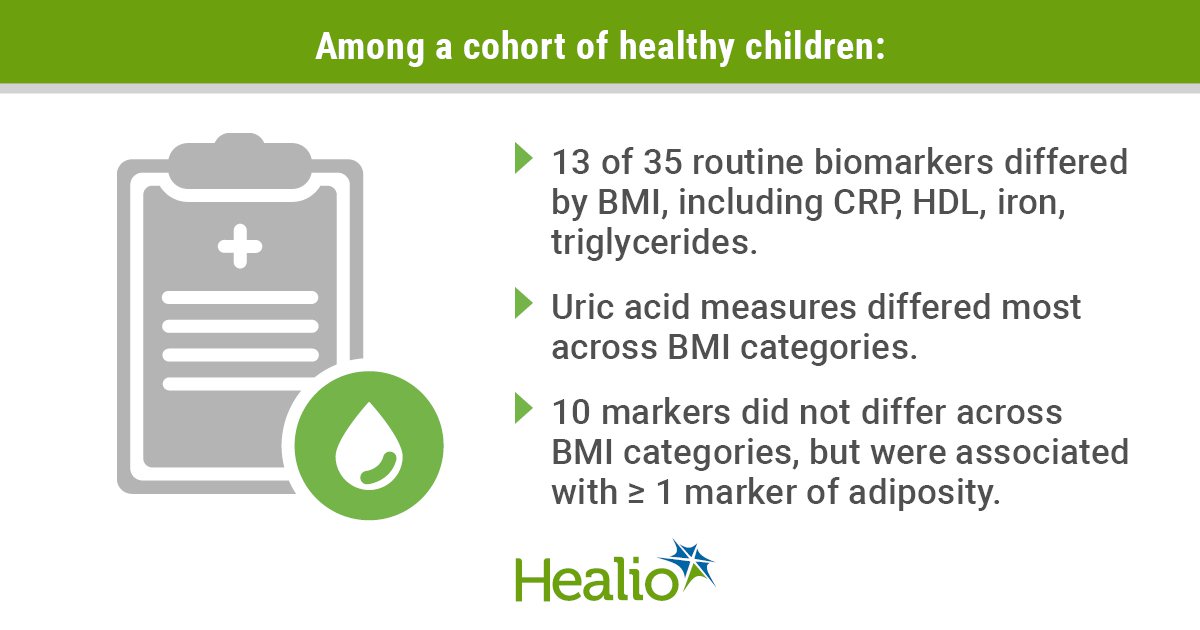Obesity may alter 70% of routine blood tests for children
Click Here to Manage Email Alerts

Obesity may affect a clinician’s ability to correctly interpret 24 routine blood tests for children, including liver function tests, inflammation markers, lipids and iron levels, according to findings published in The Journal of Clinical Endocrinology & Metabolism.
“The results of our study clearly highlight the need for careful consideration of a child’s BMI when interpreting laboratory test results,” Khosrow Adeli, PhD, FCACB, DABCC, head and professor of clinical biochemistry at the University of Toronto and senior scientist at the Molecular Medicine Research Institute at The Hospital for Sick Children, told Healio. “Pediatricians and other health care professionals should be aware that overweight and obesity can potentially influence the normative levels of specific medical lab tests, such as inflammatory markers. However, not all medical tests are significantly affected by BMI based on our study findings. The current publication highlights the key blood tests that are sensitive to degree of overweight and obesity.”
Adeli and colleagues analyzed anthropometric data and serum samples provided by 1,332 healthy children participating in the Canadian Laboratory Initiative on Pediatric Reference Intervals (CALIPER) cohort. Researchers assessed 35 routine biochemical markers in serum samples, such as bilirubin, calcium, iron, magnesium, phosphorus and uric acid and high-sensitivity C-reactive protein, and converted BMI, waist circumference and waist-to-height ratio to age- and sex-specific z scores. Children were grouped into normal-weight, overweight and obese categories. Researchers used multiple regression analyses to assess the association between each biochemical marker and BMI, waist circumference and waist-to-height ratio z scores, adjusting for age and sex. Reference intervals were also established for all biochemical markers before and after removing participants with overweight or obesity.

Overall, 13 of 35 routinely assessed biochemical markers differed across BMI categories: alanine aminotransferase, apolipoprotein B, complement component 3, complement component 4, cholinesterase, high-sensitivity C-reactive protein, gamma-glutamyl transferase, haptoglobin, HDL cholesterol, iron, transferrin, triglycerides and uric acid.
BMI, waist circumference and/or waist-to-height ratio were associated with serum concentration of 24 of the 35 markers examined, after adjusting for age and sex.
Researchers observed the most pronounced changes across BMI categories for uric acid. For each 1 U increase in BMI, waist circumference or waist-to-height z score, mean uric acid concentration for girls increased by 14.1 µmol/L, 14.9 µmol/L and 14.7 µmol/L, respectively, and for boys by 10.3 µmol/L, 16.1 µmol/L and 11.6 µmol/L, respectively.
Researchers noted that 31% of biochemical markers examined did not differ across BMI groups and were not associated with any measures of adiposity. An additional 10 biochemical markers — albumin, alkaline phosphatase, apolipoprotein A-I, amylase, aspartate aminotransferase, bilirubin direct, bilirubin total, lactate dehydrogenase, phosphorus, prealbumin and total protein — did not differ across BMI categories; however, these were associated with at least one marker of adiposity.
“We performed the first comprehensive analysis of the effect of obesity on routine blood tests in a large community population of children and found that almost 70% of the blood tests studied were affected,” Victoria Higgins, PhD, a clinical biochemistry fellow at the University of Toronto, and The Hospital for Sick Children in Ontario, Canada, said in a press release. “As clinical decisions are often guided by normative ranges based on a large healthy population, understanding how and which routine blood tests are affected by obesity is important to correctly interpret blood test results.”
Higgins stated in the release that clinicians should be aware of these findings when interpreting several blood tests for children.
in the release. – by Regina Schaffer
For more information:
Khosrow Adeli, PhD, FCACB, DABCC, can be reached at Clinical Biochemistry, DPLM, The Hospital for Sick Children, 555 University Ave., Toronto, ON, M5G 1X8, Canada; email: khosrow.adeli@sickkids.ca.
Disclosures: The Canadian Institutes of Health Research supported this study. The authors report no relevant financial disclosures.
